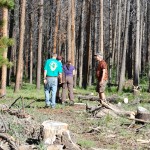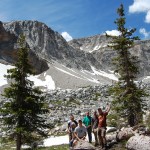 Congrats to Jessie Uehling, who recently passed her prelims. Jessie is a 2nd year Genetics Program student with interests in molecular biology and genomics of bacterial-fungal interactions. For her Ph.D. research, Jessie has chosen to study bacterial-fungal symbioses. Our lab recently discovered a very unusual bacterial endosymbiont (Glomeribacter sp.) that lives inside endophytic fungi that colonize plant roots and soil. The genome of the Glomeribacter endosymbiont is greatly reduced (2.5 mb) relative to its free-living relatives in the genus Burkholderia (typcially around 9 mb). Jessie is working with our collaborators from Oak Ridge National Labs (Jessy Labbe) and INRA (Aurelie Deveaux) to investigate the molecular mechnaisms of fungal-bacterial symbiosis.
Congrats to Jessie Uehling, who recently passed her prelims. Jessie is a 2nd year Genetics Program student with interests in molecular biology and genomics of bacterial-fungal interactions. For her Ph.D. research, Jessie has chosen to study bacterial-fungal symbioses. Our lab recently discovered a very unusual bacterial endosymbiont (Glomeribacter sp.) that lives inside endophytic fungi that colonize plant roots and soil. The genome of the Glomeribacter endosymbiont is greatly reduced (2.5 mb) relative to its free-living relatives in the genus Burkholderia (typcially around 9 mb). Jessie is working with our collaborators from Oak Ridge National Labs (Jessy Labbe) and INRA (Aurelie Deveaux) to investigate the molecular mechnaisms of fungal-bacterial symbiosis.
Before coming to Duke, Jessie earned her M.S. at Humbodlt State in the lab of Terry Henkel working on biodiversity and ecology of Clavulina species (rare and unique guild of ectomycorrhizal fungi associated with remote forest regions of Guyana).
Now into her second year as a Ph.D. student, Jessie is already a productive junior scientist with over 10 published papers arising from her MS thesis on the evolutionary systematics and ecology of mycorrhizal fungi. Good luck with your next phase, “ABD” (All but Dissertation!).





























